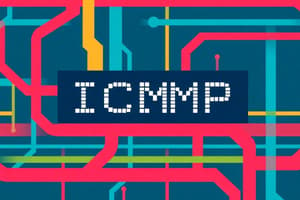Podcast
Questions and Answers
What function does NAT perform in a network?
What function does NAT perform in a network?
- It directly hosts web applications.
- It establishes direct communication between different networks.
- It translates private IP addresses to a public IP address. (correct)
- It increases network bandwidth and efficiency.
What is the purpose of ICMP in networking?
What is the purpose of ICMP in networking?
- To enhance the speed of data transmission.
- To secure data packets during transit.
- To manage bandwidth allocation across networks.
- To provide network-level information and error reporting. (correct)
What is contained in an ICMP message alongside its type and code?
What is contained in an ICMP message alongside its type and code?
- The intended recipient’s address
- First 8 bytes of the datagram causing the error (correct)
- The sender’s source address
- Checksum value for error detection
What is the primary metric used by the Routing Information Protocol (RIP)?
What is the primary metric used by the Routing Information Protocol (RIP)?
Which of the following statements about ICMP is TRUE?
Which of the following statements about ICMP is TRUE?
What algorithm does OSPF primarily employ?
What algorithm does OSPF primarily employ?
Which of the following best describes hot potato routing?
Which of the following best describes hot potato routing?
What is the stopping criteria for datagram processing related to ICMP messages?
What is the stopping criteria for datagram processing related to ICMP messages?
What is the primary motivation behind the development of IPv6?
What is the primary motivation behind the development of IPv6?
Which field in the IPv6 datagram format identifies priority among datagrams in a flow?
Which field in the IPv6 datagram format identifies priority among datagrams in a flow?
Which feature has been removed from IPv6 to reduce processing time at each hop?
Which feature has been removed from IPv6 to reduce processing time at each hop?
In the context of ICMP error reporting, what does the destination return when a UDP segment is unreachable?
In the context of ICMP error reporting, what does the destination return when a UDP segment is unreachable?
What characteristic of the IPv6 header format aids in speeding processing and forwarding?
What characteristic of the IPv6 header format aids in speeding processing and forwarding?
How are options handled in IPv6 compared to IPv4?
How are options handled in IPv6 compared to IPv4?
What issue arises during the transition from IPv4 to IPv6 regarding router upgrades?
What issue arises during the transition from IPv4 to IPv6 regarding router upgrades?
What type of ICMP message indicates that a packet is too large?
What type of ICMP message indicates that a packet is too large?
Which field in the IPv6 header indicates the upper layer protocol for data?
Which field in the IPv6 header indicates the upper layer protocol for data?
What happens to datagrams when they arrive at an nth router and are processed by UDP?
What happens to datagrams when they arrive at an nth router and are processed by UDP?
Which protocol is primarily used for dynamically assigning IP addresses to devices on a network?
Which protocol is primarily used for dynamically assigning IP addresses to devices on a network?
What additional information can DHCP provide besides IP addresses?
What additional information can DHCP provide besides IP addresses?
In a DHCP transaction, what is the significance of the transaction ID?
In a DHCP transaction, what is the significance of the transaction ID?
When is a DHCP ACK message sent?
When is a DHCP ACK message sent?
Which option describes the content of a DHCP offer?
Which option describes the content of a DHCP offer?
What is the purpose of the 'Broadcast' address in DHCP messages?
What is the purpose of the 'Broadcast' address in DHCP messages?
Which of the following correctly describes a DHCP request message?
Which of the following correctly describes a DHCP request message?
What is typically included in a DHCP ACK message?
What is typically included in a DHCP ACK message?
What does the 'lifetime' value in a DHCP message indicate?
What does the 'lifetime' value in a DHCP message indicate?
Which component is necessary for a device to receive a DHCP address on a local network?
Which component is necessary for a device to receive a DHCP address on a local network?
Flashcards
ICMP
ICMP
Internet Control Message Protocol used by hosts and routers for network-level communication, primarily for reporting errors and controlling congestion.
Echo Request/Reply (ping)
Echo Request/Reply (ping)
An ICMP message type used for testing network connectivity by sending an echo request and receiving an echo reply.
Destination Unreachable
Destination Unreachable
An ICMP error message indicating a destination host, network, protocol or port is unreachable.
Traceroute
Traceroute
Signup and view all the flashcards
Time-To-Live (TTL)
Time-To-Live (TTL)
Signup and view all the flashcards
IP Datagram
IP Datagram
Signup and view all the flashcards
Routing Algorithms
Routing Algorithms
Signup and view all the flashcards
Hierarchical Routing
Hierarchical Routing
Signup and view all the flashcards
IPv6 Motivation
IPv6 Motivation
Signup and view all the flashcards
IPv6 Header
IPv6 Header
Signup and view all the flashcards
IPv6 Datagram Format
IPv6 Datagram Format
Signup and view all the flashcards
IPv6 Priority
IPv6 Priority
Signup and view all the flashcards
IPv6 Flow Label
IPv6 Flow Label
Signup and view all the flashcards
IPv6 Checksum Removal
IPv6 Checksum Removal
Signup and view all the flashcards
IPv6 Options
IPv6 Options
Signup and view all the flashcards
Stopping Criteria
Stopping Criteria
Signup and view all the flashcards
Transition from IPv4 to IPv6
Transition from IPv4 to IPv6
Signup and view all the flashcards
Intra-AS Routing
Intra-AS Routing
Signup and view all the flashcards
RIP (Routing Information Protocol)
RIP (Routing Information Protocol)
Signup and view all the flashcards
Distance Vector Algorithm
Distance Vector Algorithm
Signup and view all the flashcards
RIP Advertisement
RIP Advertisement
Signup and view all the flashcards
RIP Hop Limit
RIP Hop Limit
Signup and view all the flashcards
DHCP Offer
DHCP Offer
Signup and view all the flashcards
DHCP Request
DHCP Request
Signup and view all the flashcards
DHCP ACK
DHCP ACK
Signup and view all the flashcards
DHCP Purpose
DHCP Purpose
Signup and view all the flashcards
DHCP Server
DHCP Server
Signup and view all the flashcards
DHCP Client
DHCP Client
Signup and view all the flashcards
yiaddrr
yiaddrr
Signup and view all the flashcards
Transaction ID
Transaction ID
Signup and view all the flashcards
Lifetime
Lifetime
Signup and view all the flashcards
Network Mask
Network Mask
Signup and view all the flashcards




